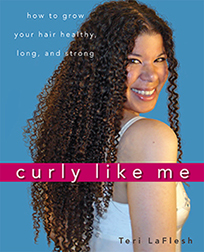
Available now!
Curly Like Me, the off-the-grid, do-it yourself owner's manual for tightly curly hair, is ready for ordering. Grab your copy today!

Every purchase made from
this site (through Amazon)
helps support it — and it
doesn't cost you anything
extra.
|
|
In the ingredient descriptions: Good means that I like to see this in a product's list of ingredients. Okay means this product appears safe for a curly person like me to use. Caution means that this ingredient may not be good in some hair care products, or for some people. Avoid means this ingredient may hurt your hair. If you see this ingredient in a hair product, it's best to put it down and walk away.
|
|
| |
Soap
Avoid
Soaps are the oldest cleansers, usually made from an oil or fat, and a highly alkaline substance, like lye (sodium hydroxide) added to it. A more mild soap could be made from fatty acids added to it. Even soaps that are neutral are highly alkaline. They can have a pH of as high as 10 (skin has a pH of 5 to 6.5). [Winter 7th edition page 469]. Those with a pH below 8 are considered conditioning [Hunting (Shampoo) page 352]. These are very drying for the hair, and may even damage the cuticle, because they are very alkaline [Begoun pg 73]. For more information, see Soaps vs Surfactants?, or soap.
Soaps are used for their cleansing and foaming abilities, and are often put in products for marketing purposes (it sounds natural). They are known as irritants, but they are also known as being safe (besides the irritation). Shampoos used to be made with soap, but when the milder modern synthetic detergents became available, the detergents replaced the soaps. Soaps don't do nearly as well as the modern synthetic detergents in hard water, and can often leave a film [Hunting (Shampoo) pgs 352-353]. Per Begoun (Don't Go to the Cosmetics Counter Without Me) page 1336, true soaps do not have to list their ingredients on the label, and are made up of only fats and alkali.
See also:
Irritant Saponification
Source(s):
Begoun Hunting Winter http://thebeautybrains.com/2008/11/17/what-is-the-difference-between-soap-surfactants/ https://en.wikipedia.org/wiki/Soap
|
Soapbark
Okay
Can clean slightly, and can serve to keep products from separating. Pg 450.
See also:
Saponin
Source(s):
Winter
|
Soap Bark
(aka Quillaja bark extract; Quillaja Saponaria; Quillay Bark; Panama Bark; China Bark)
Okay
See Quillaja bark.
See also:
Quillaja bark
|
Soapwort
Okay
Can clean slightly. May have anti-inflamatory properties. Pg 270-271.
See also:
Saponin
Source(s):
Begoun
|
|
References:
Applewhite, Thomas H., ed. Proceedings of the World Conference on Lauric Oils: Sources, Processing, and Applications
AOCS Publishing, 1994.
Barel, André O., Marc Paye, and Howard I. Maibach., eds. Handbook of Cosmetic Science and Technology, Second Edition
Marcel Dekker, Inc., 2001.
Begoun, Paula. Don’t Go Shopping for Hair-Care Products Without Me. 3rd Edition.
Renton: Beginning Press, 2005.
Begoun, Paula. The Beauty Bible.
Renton: Beginning Press, 2002.
Begoun, Paula. Don’t Go to the Cosmetics Counter Without Me.
Renton: Beginning Press, 2003.
Bellum, Sarah, ed. The Beauty Brains: Real Scientists Answer Your Beauty Questions
New York: Brains Publishing, 2008.
Gottschalk, Tari E. and McEwen, Gerald N, Jr. PhD, eds. International Cosmetic Ingredient Dictionary and Handbook, Tenth Edition 2004, Volumes 1-4.
Washington D. C.: The Cosmetic, Toiletry, and Fragance Association, 2004.
Halal, John Hair Structure and Chemistry Simplified, Fifth Edition
Albany: Milady, 2002.
Hunting, Anthony L.L. Encyclopedia of Conditioning Rinse Ingredients.
Cranford, NJ: Micelle Press, Inc., 1987.
Hunting, Anthony L.L. Encyclopedia of Shampoo Ingredients.
Cranford, NJ: Micelle Press, Inc., 1983.
Johnson, Dale H. (Ed.). Hair and Hair Care, Cosmetic Science and Technology Series. Vol. 17.
New York: Marcel Dekker, 1997. Print.
Nnanna, Ifendu A. and Jiding Xia., eds. Protein-Based Surfactants: Synthesis: Physicochemical Properties, and Applications (Surfactant Science)
Madison Heights: CRC, 2001.
Quadflieg, Jutta Maria. Fundamental properties of Afro-American hair as related to their straightening/relaxing behaviour.
Diss. U of Rheinisch-Westfälischen Technischen Hochschule Aachen, 2003.
Schueller, Randy and Perry Romanowski, eds. Conditioning Agents for Hair and Skin.
New York: Marcel Dekker, Inc., 1999.
Winter, Ruth M.S. A Consumer's Dictionary of Cosmetic Ingredients: Complete Information About the Harmful and Desirable Ingredients Found in Cosmetics and Cosmeceuticals
New York: Three Rivers Press, 2005.
Zviak, Charles., ed. The Science of Hair Care (Dermatology)
New York: Marcel Dekker, Inc., 1986.
|
|